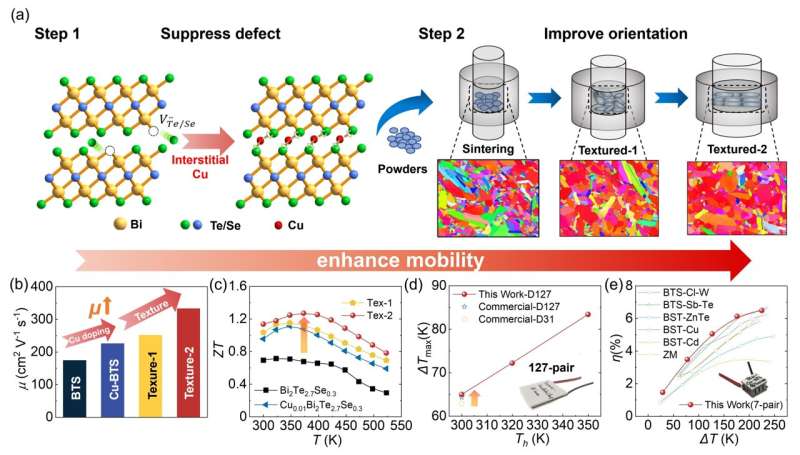This article has been reviewed according to Science X's editorial process and policies. Editors have highlighted the following attributes while ensuring the content's credibility:
fact-checked
trusted source
proofread
Study indicates interstitial Cu reduces the defect density in matrix and suppresses the donor-like effect

Due to the capacity to directly and reversibly convert heat into electricity, thermoelectric (TE) material has potential applications in solid-state heat pumping and exhaust heat recuperation, thus attracting worldwide attention. Bi2Te3 stands out for its excellent thermoelectric properties and has been used in commercial thermoelectric devices.
However, the development of Bi2Te3-based thermoelectric devices is seriously hindered by the weak mechanical properties and low TE properties of n-type Bi2(Te, Se)3. Therefore, it is important to develop a high-performance n-type Bi2Te3 polycrystalline material.
To address this issue, a study, published in the journal Science Bulletin, introduced extra Cu into the classical n-type Bi2Te2.7Se0.3 to optimize its local defect state, and a two-step hot deformation process was employed to construct the high textured polycrystalline Bi2Te2.7Se0.3 material.
This research reveals that the extra Cu is able to enter the van der Waals gaps between the Te(1)-Te(1) layers in Bi2Te2.7Se0.3 matrix, suppressing the formation of the anionic vacancies. This reduction in defect density contributes to lattice plainification in Cu0.01Bi2Te2.7Se0.3, improving the carrier mobility of Bi2Te2.7Se0.3 from 174 cm2 V–1 s–1 to 226 cm2 V–1 s–1 with the 1% additional Cu, resulting in a maximum ZT of 1.10 at 348 K.
Subsequently, the SPS-sintered Cu0.01Bi2Te2.7Se0.3 bulk material underwent a two-step hot deformation process. Since the interstitial Cu can stabilize the lattice and effectively suppress the donor-like effect. The carrier concentration of hot deformation sample remains almost unchanged, while its grain orientation and grain size have significantly increased, which dramatically boosts the carrier mobility, from the initial 174 cm2 V–1 s–1 to 333 cm2 V–1 s–1, representing a 91% increase after the hot deformation process.
This significant improvement in electronic properties contributes to a substantial enhancement in ZT for hot deformation sample. The ZTmax of the textured Cu0.01Bi2Te2.7Se0.3 reaches 1.27 at 373 K, and its average ZT value is 1.22 in the range of 300-425 K, nearly twice as much as the initial Bi2Te2.7Se0.3.
Furthermore, a 127-pair thermoelectric cooling device (TEC) was fabricated by using the textured Cu0.01Bi2Te2.7Se0.3 sample coupled with commercial p-type BST. The TEC module achieved cooling temperature differentials of 65 K and 83.4 K at hot-end temperatures (Th) of 300 K and 350 K, respectively, which is superior to the commercial Bi2Te3-based TEC modules. And a 7-pair thermoelectric generator module (TEG) was constructed by using the same materials.
The TEG module demonstrated a significantly high conversion efficiency of 6.5% at a temperature different of 225 K, which is comparable to other state-of-the-art Bi2Te3-based TEG modules.
More information: Yichen Li et al, Realizing high-efficiency thermoelectric module by suppressing donor-like effect and improving preferred orientation in n-type Bi2(Te, Se)3, Science Bulletin (2024). DOI: 10.1016/j.scib.2024.04.034
Provided by Science China Press





















